Around the world and in many parts of the United States, people are wearing masks to prevent the spread of COVID-19. This creates a real challenge for human communication, whether it’s in a grocery store, classroom, or workplace.
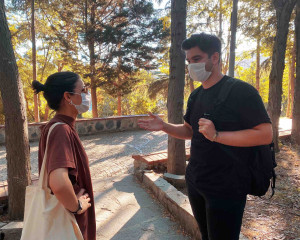
“It’s harder to connect with another human being when you can only see a third of their face,” says John Rose, who teaches about happiness and ethics at Duke University.
He notes that we convey warmth through smiles, which isn’t really an option in an all-mask environment. That “makes it harder to teach because I want to know, are they surprised, confused, do they find it funny?”
Rose is right to be concerned. We need to mask up in a global pandemic that has killed millions of people—but more and more research suggests that masks do inflict a penalty on person-to-person communication. Fortunately, much of the same research suggests that we can work around our masks through gestures, voice, and especially eye contact.
While this work has practical implications for communication during a pandemic, the science also reveals how the different components of human communication interact so that we can identify and understand each other.
What we miss when we mask
“In losing the lower portion of the face, we lose enormous amounts of information about another person’s emotion,” says Dacher Keltner, a UC Berkeley psychologist and cofounder of the Greater Good Science Center. “The lower face includes actions that powerfully signal emotion, such as lip puckers, presses, open mouths, and lip licks.”
He adds, “Studies reveal that even though we see the eyes, knowing that someone is showing the orbicularis oculi contraction around the eyes, we still lose the ability to see if someone is loving or desirous, or amused or content, or astonished or joyful.”
Many studies suggest that the upper and lower halves of the face work together to communicate emotion—and if that link is broken, then humans struggle to comprehend each other. Keltner uses the example of seeing a furrowed brow over a mask. Without the lower face, he says, “We don’t know if that is a sign of anger, which involves the tightening of the buccinator muscle around the mouth, or concentration, which doesn’t involve that muscle action.”
Masks affect identity recognition, as well—which isn’t at all surprising, on the levels of both common sense and science. Indeed, outside of the context of a global pandemic, the whole point of most mask-wearing is to hide or change identity.
In a pandemic, the implications of this fact are somewhat complex. The research to date suggests that our brains develop feelings about someone as our recognition of them grows. We track changes in expression along one neural pathway, and we identify people in a specialized region of the brain called the fusiform face area. It’s the interaction between these two pathways that make other people socially meaningful to us.
Masks inhibit that process—and thus create significant potential for social and emotional misunderstanding.
How masks affect trust
In a recent paper published in Scientific Reports, Malte Reichelt and her colleagues studied the impact of masking on trust. They asked a representative sample of over 2,000 Americans to take part in a game where they were offered advice by a stranger in a video, who is sometimes masked and sometimes unmasked.
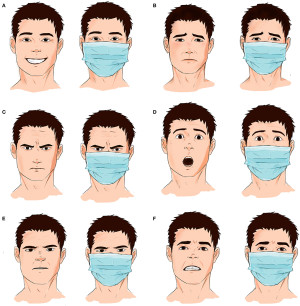 (A) Happiness is usually perceived when the corners of the lips rise upward. With face masks, happiness can be caught on the face by focusing on the wrinkles at the edge of the eyes. (B) Sadness involves movement of the eyebrows, the nasolabial folds, and the corners of the lips; however, the last two are masked by face masks. (C) Facial expression of anger emphasizes the downward and central movement of eyebrows, the glaring eyes, and narrowing of the corners of the lips, with the latter getting covered by face masks. (D) Expressions of surprise and shock are usually formed of elevated eyebrows and a raised upper lip; only the latter is covered by protective masks. (E) Nose wrinkling and raising of the upper lip convey feelings of disgust; however, face masks cover both expressions. (F) Feelings of guilt are usually portrayed by slightly upping eyebrows together and stretching the mouth, with the latter getting covered with a face mask.
© "Effect of Face Masks on Interpersonal Communication During the COVID-19 Pandemic," by Nour Mheidly, Mohamad Y. Fares, Hussein Zalzale, and Jawad Fares: Frontiers in Public Health, December 2020.
(A) Happiness is usually perceived when the corners of the lips rise upward. With face masks, happiness can be caught on the face by focusing on the wrinkles at the edge of the eyes. (B) Sadness involves movement of the eyebrows, the nasolabial folds, and the corners of the lips; however, the last two are masked by face masks. (C) Facial expression of anger emphasizes the downward and central movement of eyebrows, the glaring eyes, and narrowing of the corners of the lips, with the latter getting covered by face masks. (D) Expressions of surprise and shock are usually formed of elevated eyebrows and a raised upper lip; only the latter is covered by protective masks. (E) Nose wrinkling and raising of the upper lip convey feelings of disgust; however, face masks cover both expressions. (F) Feelings of guilt are usually portrayed by slightly upping eyebrows together and stretching the mouth, with the latter getting covered with a face mask.
© "Effect of Face Masks on Interpersonal Communication During the COVID-19 Pandemic," by Nour Mheidly, Mohamad Y. Fares, Hussein Zalzale, and Jawad Fares: Frontiers in Public Health, December 2020.
They found that around 5% fewer individuals trusted advice when it was given by someone wearing a mask, which suggests that masking can reduce trust. When the researchers looked more closely at the people who were less likely to trust, economic hardship seemed to be the most important variable: People who were unemployed or underemployed in the previous year—or who had partners in that boat—were significantly less likely to follow advice by a masked stranger.
Beliefs mattered, too. Americans who didn’t believe that masks work in preventing COVID-19 were significantly less likely to trust the masked stranger. To Reichelt, that means people need to be more educated about the necessity of masks. “Increasing trust among one another would likely be facilitated if masks were only seen as protective and less as an ideological symbol,” suggests Reichelt, an assistant professor of social research and public policy at NYU Abu Dhabi.
It follows that believing in masks would lead to greater social trust—and, in fact, that was the result of another new study conducted deep into the pandemic. When a team of Italian researchers evaluated trust across three circumstances—no mask, transparent mask, and standard mask—they found that standard medical masks actually made people trust each other more. This result confirms an observation from an earlier study of masks and trustworthiness during the pandemic.
“We speculate that, as the study was conducted during the pandemic, facemasks are taken as a proxy of social compliance and caring,” write the Italian researchers.
Even so, the standard medical mask still reduced people’s ability to accurately perceive identity and emotion. Taken together, these studies suggest a bottom line: Understanding the necessity of masks seems to help bring us together, but it still hobbles our ability to connect.
Your voice and gestures are powerful
So, does this mean we are doomed to confusion and conflict in the time of the mask and social distancing? Absolutely not. Humans still posses an arsenal of ways to comprehend each other.
Our sounds might be sometimes muffled, but according to a 2019 study by Keltner and his colleagues, we can convey 24 kinds of emotion through our voices alone. One 2017 study even found that the voice can communicate more emotion than the face. And in brain scans of people engaged in only vocal communication, researchers found that their neural activity still gradually synchronized, even when faces were hidden. The more their brains came to mirror each other, the more they understood the content of each other’s speech.
We can also gesture with our hands to convey nuance and meaning.
A string of experiments conducted in the 1970s found that observers can guess the identity of a conversational partner with a hidden face from their gestures alone; even very young children can do this. Through watching gestures, we can tell friend from stranger, gauge their emotional state, and even accurately guess their age.
We don’t just “talk” with our hands. Kneeling, for example, can communicate submissiveness, reverence, deference, mourning, and vulnerability. When actively listening to another person, we nod, lean forward, and avoid defensive postures like folding our arms or turning away.
However, our most important resource lies in our eyes.
What your eyes can do
Parents naturally train their children from birth to communicate through the eyes, by gazing warmly at them or through games like peek-a-boo. That’s a skill we develop throughout our lives.
Humans possess an uncanny ability to detect another person’s gaze through subcortical neural pathways—and feeling eyes on us involuntarily activates social cognition centers of the brain. In other words, we immediately become self-conscious and get ready for social interaction.
Among both human and nonhuman primates, eye contact is a signal of social intent. Human beings can see at a glance if another person wants to hug us, attack us, or run away from us, based only on the information we find in and around their eyes.
According to research, making eye contact can activate the brain’s reward system, if it’s with a friend—or trigger the amygdala, if we perceive a threat. In a conversation, eye-to-eye contact synchronizes the frontal temporal and parietal systems “within and across brains.” Whether it’s in person or over Zoom, according to one new study, locking eyes activates the autonomic nervous system and can trigger a smile. It can also signal a turn in a conversation, from one topic to another.
In short, the eyes do a lot of the work of communication—and that’s especially true when we’re wearing masks.
Rose, the Duke professor, has seen this firsthand in his seminar course that aims to discuss controversial topics freely. In these sometimes-tense classroom discussions, masks can be an impediment to empathy and understanding. To get around that obstacle, Rose has learned to rely on other aspects of human communication.
“I think I’ve gotten better at reading people’s eyes,” he says. “I think the other thing is that it forces you in your communication skills to really articulate and really be clear.”
Of course, communication through the eyes goes both ways. Rose’s insight is echoed in a study by Eeva Haataja and her colleagues, which used gaze-tracking glasses and video cameras to observe communication with three teachers and their 47 students.
The researchers found that students would gaze at teachers’ faces more when those teachers exhibited two different qualities. The first was a high level of “communion,” which could be defined as friendliness or warmth. The second was a low level of agency, which could be defined as showing control or direction.
Of course, culture plays a role in shaping communication through eye contact. As a team of University of Wisconsin researchers write in one 2020 article:
The frequency and duration of eye contact is lower in East Asian, than in Western European and American, cultures. Japanese adults engage in significantly less eye contact than do either Canadians or Trinidadians during face-to-face interactions. There is also cultural variation in how eye contact is interpreted, with East Asians, as compared to Western Europeans, viewing eye contact as more aggressive and signifying that a person is less approachable. In addition, in many Asian as well as Middle Eastern cultures, the use of eye contact and staring is also a way to convey social status and rank, obliging subordinate individuals to avert or lower their gaze.
Teachers have a range of tools they can use even while they’re masked to communicate, says Haataja, an academic at the University of Helsinki—as do the rest of us, whether we’re at work or in a store.
“In the end, it’s the eyes that are the most important source of emotional information to other people,” Haataja said. “We know that already from small children that it’s the eyes that we look at when we look at other people and we try to interpret the emotions or behaviors of other people.”
Five tips for communicating around your mask
But of course, as we’ve seen, it’s not just eye contact that we can utilize to ensure we have good communication with others. It’s also important for us to adopt an appropriate tone of voice, body posture, and welcoming speech in order to build bonds with the people around us. Here’s a roundup of the ways we can better communicate during COVID-19.
1. Assert the importance of masks in preventing infection, but acknowledge the challenges they create. The evidence is clear: Widespread, correct use of masks prevents community spread of COVID-19. It’s important to say this to each other because it helps us to accept their reality and necessity, in the same way we accept wearing glasses when our vision is bad or wearing a jacket when it’s cold. Adults come to accept these items because we know their advantages outweigh any inconveniences or constraints they might impose. However, this acceptance can open the door to awareness of the drawbacks, which can help us to be more generous with each other when miscommunication happens. It might be important to state both the necessity and challenges aloud, to help everyone remember that they’re facing special conditions.
2. Cultivate mindfulness while wearing a mask. In a paper published last year, Mathias Schlögl and Christopher A. Jones—both medical doctors who specialize in the treatment of dementia—point to simple mindfulness as a way to make yourself understood through a mask. They suggest creating a personal ritual before visiting patients, which is advice that can also apply to educators or anyone running a meeting. “Once we become more aware of our characteristic gestures and body language, we can then go about aligning our nonverbal signaling with our spoken message,” they write. “If we do not practice the habit of underlining everything we say with gestures and pantomime, the message we convey might be harder to interpret.”
3. Remember that you have eyebrows, eyes, body language, and a voice. For some people, gesticulating and modulating your voice will come naturally; for them, these habits of communication might predate the pandemic. For others, such expressiveness might require more intention and effort. Don’t be afraid to waggle your eyebrows, squint, wave your hands around, or allow more feeling into your voice. Because the mask muffles your voice, you might need to raise it to a level that feels unnatural, and try to enunciate and speak slower than you might otherwise. Remember that communication is a skill, one at which you can get better.
4. Explore the roles of culture and personality. Eye contact and hand gestures mean different things in different cultures. Individuals also have preferences, of course, and they might even have mental or physical conditions that affect nonverbal communication. Time permitting, it might be helpful, at work or school, to have explicit conversations about preferences and expectations. This helps people to get to know each other better, of course, and it can build bridges across differences.
5. Cultivate connection, warmth, and responsiveness. Face the person with whom you’re communicating. Though the protocols of eye contact will vary across cultures, you should at least make sure you have their attention, like a bicyclist at an intersection who makes eye contact with a driver before going through. Make an effort to be warmer and friendlier than you might normally be, to overcome the impediment of a mask. You might also make it a point to check in, from time to time: “Are you hearing me OK? How are you feeling? Should we continue or take a break?” Because communicating in a pandemic consumes more energy and bandwidth than in normal times, people might become tired more easily. Give yourselves frequent breaks, and don’t be afraid to share where you’re at.
“Be as friendly as you can towards the students, whether they’re small children or university students or anything in between,” says Haataja. “Especially during times like this when many of us are struggling with personal issues.”
All this can be difficult, Rose stresses—but in the process we might be gaining new communication skills. “I suppose when we go back to being without masks we’ll all be that much better at communicating,” he says. “To me, it will feel like an athlete taking off ankle weights.”


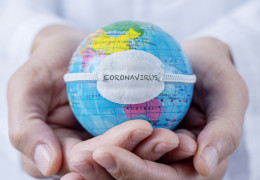



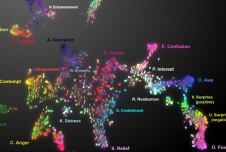

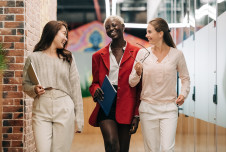

Comments